We are living in an era of information overload. So much content is shared online that curation is needed as a way to get value out of the information flood.
Content curation is the process of shifting through the vast abundance of content on the Internet to select the best, most relevant resource, on a specific topic or theme, so that we can organize, manage and collate the content for ourselves and share with others.
Content curation is about working smarter and not harder. Content curation is also a reflective process; as you curate resources you reflect on their value. Reflection makes new information stick in your brain.
Why is curation important?
Curation is a life skill and an important part of being digitally literate. Educators need to know how to curate information so they can teach students how they can curate content for research, their interests and passion. As part of this process educators need to encourage students to curate information using techniques that address their own personal learning needs.
While at the Edutech National Congress & Expo I curated the best resources shared from the Edutech conference into a Flipboard magazine. An important lesson I learnt from curating the Flipboard magazine is curation is a very personal process. As individual we have our own different learning styles and techniques; and this can be reflected strongly in how we curate and share content.
The purpose of this post is to showcase all the different ways content was curated at the Edutech National Congress & Expo to:
- Provide a deeper understanding of curation.
- Provide inspiration to try alternative curation methods.
- Make you appreciate the importance of curation.
Watch Harold Rheingold’s interview with Robin Good to learn more about curation.
The curation process
The curation process includes the following types of tools:
- News discovery tools – used select and aggregate the content. All about saving time by feeding you the most relevant content. Examples of news discovery tools include Feedly, Flipboard and following a hashtag in Twitter.
- Curation tools – used to display your content with context with organisation, annotation and presentation. Check out these examples of content curation tools.
At a conference you might also use note taking tools such as Google Docs or Evernote to document information from each session, then supplement your information by finding additional content using news discovery tools and finally share the most relevant resources with your network using curation tools.
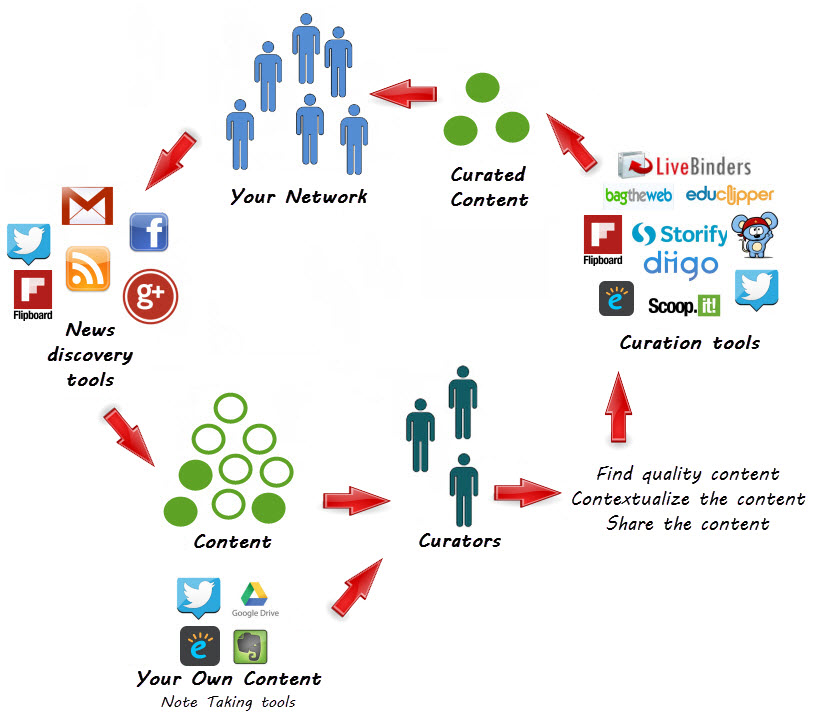
Curation tools
There are a gazilion tools you can use.; and which tools you use, and how you curate, is a personal as the tools you use to build your personal learning network (PLN).
Curation is as simple as:
- Find the tool(s) that you prefer to use for news discovery and for curation.
- Curate the content that helps you, and is helpful for others.
- Make it part of your routine to curate and share content.
Popular Curation tools
Here is a summary of popular curation tools from our survey of 190 educators.
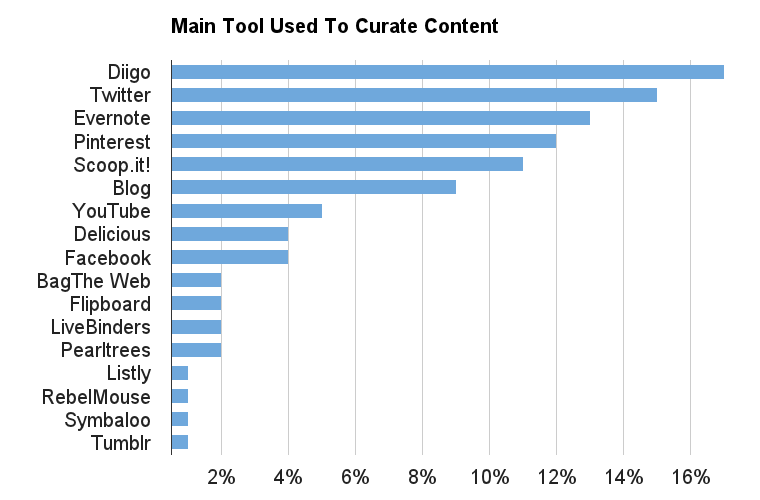
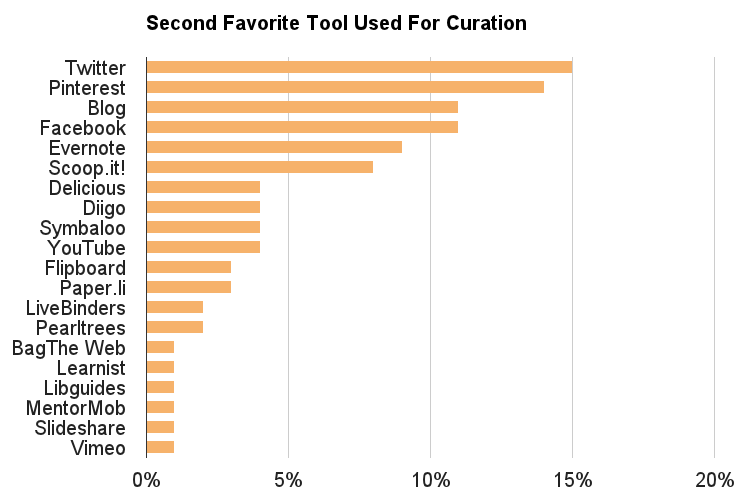
Below are examples of all the different ways educators used to curate or share information from the Edutech National Congress & Expo. Comparing the tools used to curate at EduTech with the curation survey results highlights choices are personal and based on the outcome you’re trying to achieve.
Blog posts
Blogs posts are a popular way of curating content because:
- Allows for a detailed followed up and elaboration.
- You can customize and organize vast amounts of information in meaningful ways.
Check out Silvia Rosenthanal’s post on blogging as a curation platform for more information.
There are two main approaches used for conference presentations:
- Reflective post – your reactions to their presentation and your thoughts on what they are saying/shared.
- Summary post – summary of the content shared during the presentation.
Martin Pluss’s Sir Ken Robinson’s Keynote EduTech 2014 post is the most amazing example of a summary post. Martin wasn’t at the conference. He wrote this post entirely by curating tweets shared using the #edutech hashtag. Any tweets he wanted to refer back to later he marked as favorite using his twitter client. You’ll find Martin’s EdutTech Day 2 post here.
Below are Martin’s favorited tweets from Ian Jukes’s presentation:
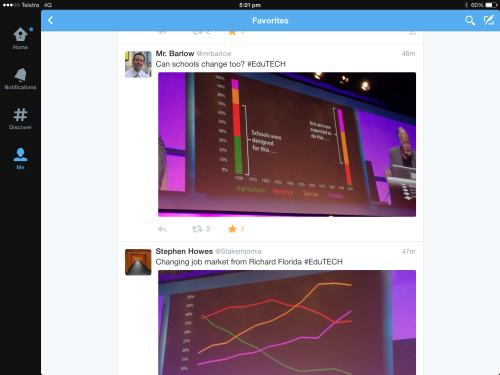
Here is how you can do this using TweetDeck:
1. Add your hashtag term to the search box in TweetDeck and press Enter.

2. When the search window loads click on Add Column.
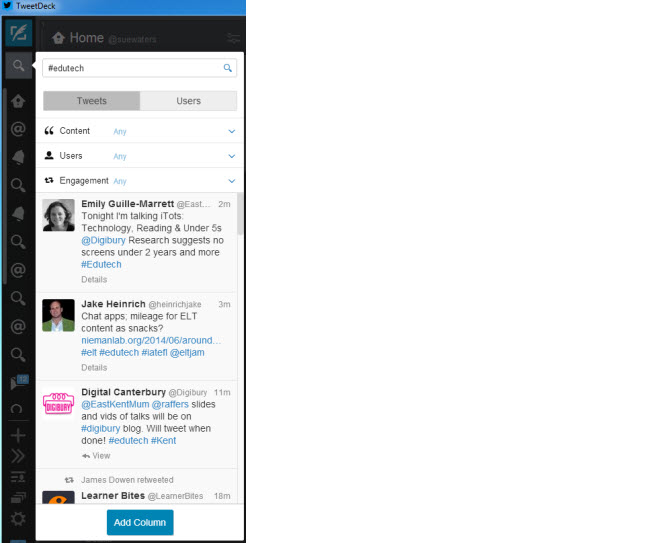
3. Your search column will load in TweetDeck and all tweets using that hashtag will be updated as they’re tweeted.
4. Mark any tweets you want to refer back to later by clicking on Favorite.
Favorites are represented by a small star icon next to the tweet and are normally used when a twitterer wants to save (refer) to a tweet later.
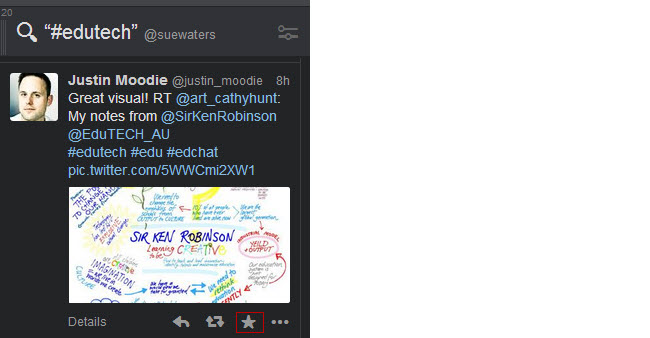
Learn more about using TweetDeck here.
Here are examples of reflective posts from the Edutech conference:
- Graham Wegner’s EduTech 2014
- Graham Wegner’s EduTECH 2014 – Virtual Version
- Vanessa Hardy’s Edutech 2 June, 2014
- Claire Amos’s EduTECH Sugata Mitra on The Future of Learning
- Claire Amos’s EduTECH – Ian Jukes on the Educaton in the Age of Disruptive Innovation
- Claire Amos’s Ewan McIntosh: Agile Leadership of Learning
- Claire Amos’s EduTECH – The Almighty Ken Robinson
- Edutech 2014 & Disruptive Innovation
- Michael Coghlan’s Edutech Conference Day 1
- James Maitland’s Too long away EduTECH the most important week of my teaching career
- Living on the Future Edge
- Judith Way’s My Take on EduTECH 2014
- Judith Way’s Edutech 2014 Part 2
- Corinne Campbell’s Knowledge builds a fence around learning
- EduTECH Theme #1 – Changing Education Paradigms – Ian Jukes
- Mister Foale’s Put up your Jukes. How Ian challenged my smugness at Edutech
Brainstorming tools
Brainstorming tools allows you to collaboratively organize your thoughts and ideas. Mind Doodle is one such mind mapping tool. It has a task board built-in, making it an excellent tool for curating resources in an education setting.
Students can use this free tool to make a visual mind map of all their resources, which can
later be exported as an image, Microsoft PowerPoint or Word Doc. They can set themselves
tasks based on which content needs further investigation, and which content would make a
useful resource for an essay, homework project or exam.
Flipboard is my main news discovery and curation tools because:
- It allows me to easily aggregate content from a range of different sources.
- Quickly curate and share articles I like directly to my own magazine from within Flipboard, using the Flip It bookmarklet in my web browser, while also sharing the articles with my social networks at the same time!
For conferences and twitter chats I subscribe to hashtags inside my Flipboard account. Tweets using the hashtags are automatically feed into Flipboard where I read through the information shared and then curate the best resources into my FlipBoard magazines.
Here is what it looks like inside my Flipboard account.
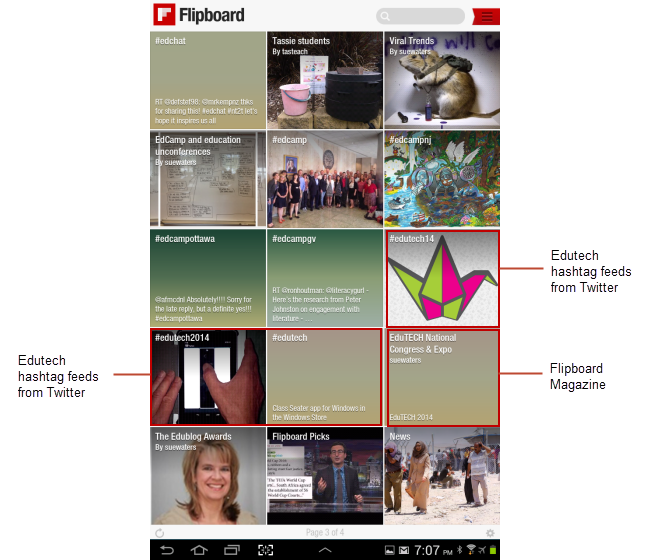
Here is a link to the Flipboard magazine I created for the Edutech Conference
This video explains how I use Flipboard to find, curate and share content. You’ll find a complete step by step guide to setting up Flipboard here.
Infographic
Another way to curate information is to use an Infographic. When students create infographics, they are using information, visual, and technology literacies.
Check out Paul Hamilton’s infographic.
My Edutech 2014 reflections. Such an inspiring event.#edutech #edutech2014 #edtech #edtechchat pic.twitter.com/hhuAXw2OXJ
— Paul Hamilton (@PaulHamilton8) June 7, 2014
Here is where you’ll find more information on infographics.
Scoop.it!
Scoop.it! is a curation platform that enable users to collect news, articles, and other sources found on the Internet, and share them on their own custom-themed Scoop.it! site. Scoop.it! is like a social bookmarking website but with a visual, online magazine-like format.
Some bloggers set up their Scoop.it! account to autopost their scoops to their blog. You can also embed a link to your Scoop.it site in a post or page.
Reason why educators use Scoop.IT include:
- Provides a visual space to curate specific topics into elegant magazines.
- Visually attractive, customizable and connects easily with other social media services. Scoop.IT allows you to curate and publish content simultaneously and easily.
- Provides useful analytics.
- Easily access curated content on all devices.
Here’s Learning E-nabling Scoop-it! from the Edutech Conference.
Slideshare
SlideShare is a site where you can host your presentations and share with others. Slideshare is ideal for those who want to embed Presentations in their posts and websites rather than upload their PowerPoints directly and insert as a link.
It’s also an excellent site for locating Presentations created by others.
Check out the following Slideshare created to share information from the EduTech Conference.
Storify
Storify allows you to curate your own stories from photos, video, tweets, what people post on social media sites and your own narration.
kdcollins_ed’s EduTech 2014 is an excellent example of using a Storify for curating a conference.
Here are other Storify’s created from the conference:
- Judy O’Connell’s EduTech 2014
- Rolfe Kolbe – EduTECH 2014 Day 1
- Corrine provides us with insight into #EduTech
- Coriel’s Agile Leadership in Learning
- Corisel’s Tom Barrett: Creativity and the Australian Curriculum
- Donelle Batty Masterclass with Sugata Mitra
- Fran Hughes Edutech – Sugata Mitra
Here’s a quick video on how to use Storify.
Visual Notes
Visual notes created on tablets were very popular at the EduTech conference.
Below is a selection of just some of the great visual notes shared!
https://twitter.com/art_cathyhunt/status/473731001869291520/
https://twitter.com/hogesonline/status/473614454156840960/
https://twitter.com/duncanpollock/status/473798136897343489/
https://twitter.com/ZeinaChalich/status/474422909830590464/
Video hosting websites
Videos are a great way of curating and sharing content.
Check out Claire Amos’s EduTECH – What we heard and what we took away video.
What do you think?
Remember the examples I’ve provided were of all the different ways educators used to curate or share information from the Edutech National Congress & Expo. Other popular curation tools include Diigo, Twitter, Evernote, Pinterest, Facebook, BagtheWeb, Livebinders, Pearltrees, Listly, RebelMouse, Symbaloo, Delicious, LibGuides, MentorMob.
Have I missed any important curation tips? I would also love to hear how you curate!
Let me know in the comments below and I will be sure to add it to the post!


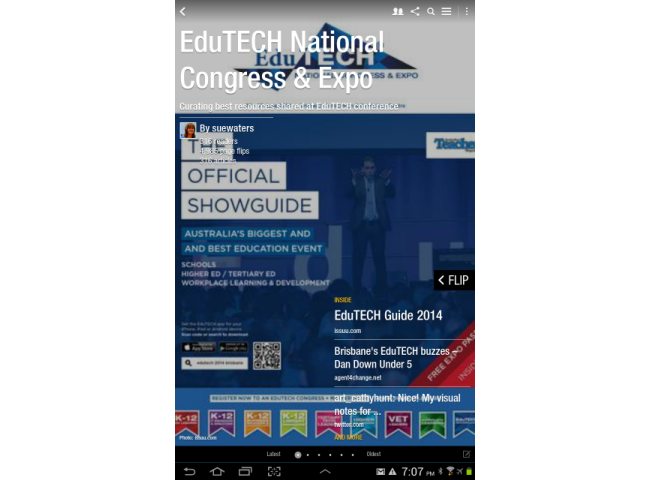
What a great article! I have only recently discovered the term/idea of curating and am exploring it for use in my classroom and with my colleagues. We teach primary students, and I am interested in various ways to filter down the overload of resources to find the most appropriate content.
For the record, I already use Symbaloo with moderate contentment. I do find it very useful for some things, but frustrating for others. Have you checked out a new tool/site called 30 hands learning? I am finding it has a lot of potential, although it is not initially geared for young classrooms. It is still a newer tool, and the developers are very open to discussing what works and doesn’t work for teachers. They answer questions directly and quickly.
You have just introduced me to a wealth of new tools to check out. Thank you!
-Deirdre Bergeron
Hi Sue,
Another great post, (you folks are really kicking goals at the moment) :). I especially like the stats related to the tools, interesting. If it’s of any interest, have a look at http://goo.gl/uTU8pE , my Curation slidedeck, (I think your paper.li gets exemplified). The deck also contains a link to some ideas I had on using a couple of tools in the classroom, (see http://goo.gl/pQKfh), which I presented at a Teachmeet to which Celia Coffa responded with http://goo.gl/ft5gN2. Fun…..
Perfectly explained and so needed. I’ve shared you post at our #clmooc ; we have many newbies flooded with information who will learn much from this post — as will experienced webbers. Thank you, Sue!
Delightful, Sue. I wondered how long this post took to write. I see curation in general, and your work in particular, as wonderfully altruistic.
Best wishes
Keith
Hi Rolf – Thanks for the nice feedback. Hope the links to all the content from EduTECH helped.
Hi Kim – Thanks for sharing GroupMap. I will definitely check it out. Do you have a link to a GroupMap you’ve created? I haven’t published the results from latest year’s curation survey and have considered what is the best way of re-surveying it again this year. One aspect I hadn’t considered in the original survey, which was highlighted when I curated the Flipboard Magazine, was the impact of what we were curating and what we were trying to achieve has on our choices. That aspect is really hard to include in a survey.
Hey Sue, You might look to adding GroupMap to your brainstorming tools – allows a range of structured collaborative mapping.
What a fantastic post on so many fronts, thank you! A great summary of curation tools with examples of use and also the best round up of personal takes on the EduTech conference as well. Thanks!